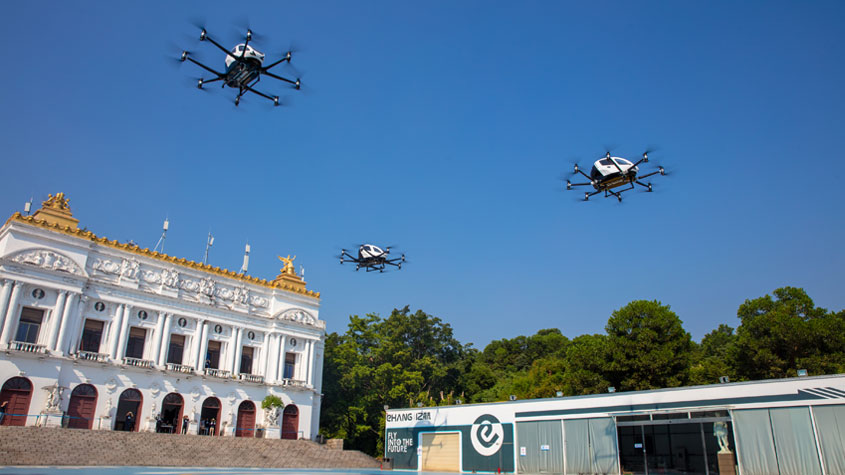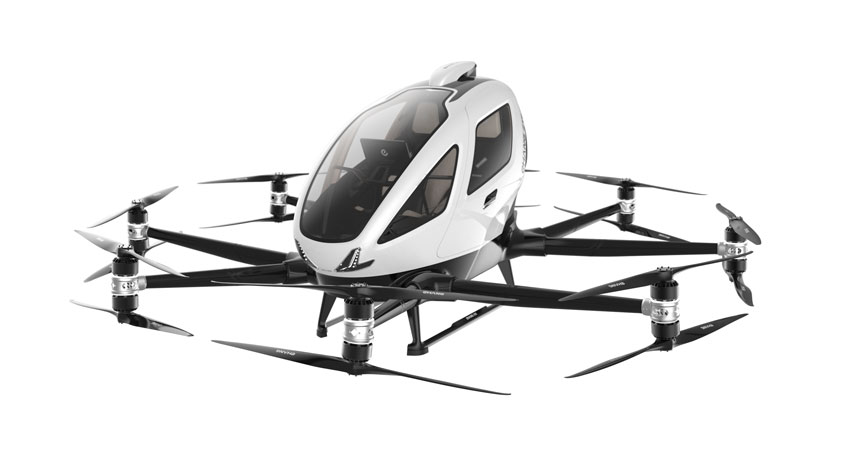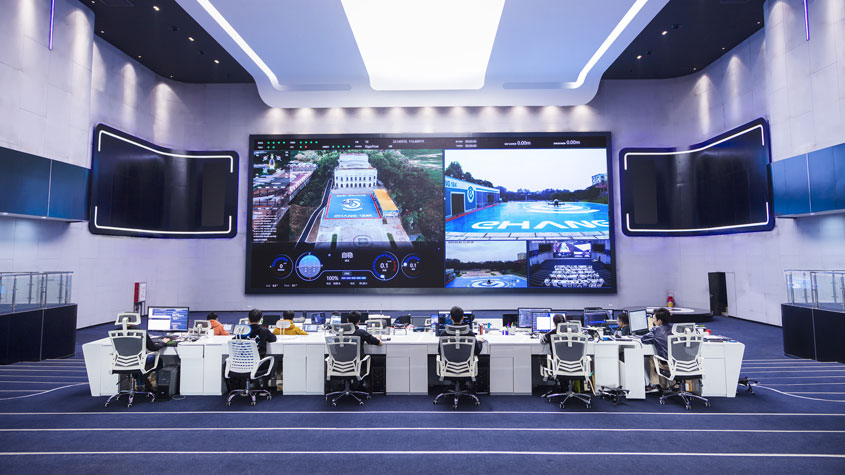EHang: The Sky’s the Limit
Guangzhou EHang Intelligent Technology Co., Ltd. is a world-leading autonomous aerial vehicle (“AAV”) technology company. Known as "EHang”, the company develops autonomous aerial vehicle (AAV) products and commercial solutions, including air mobility (passenger transportation and logistics), smart city management and aerial media solutions. Their mission is to make safe, autonomous and eco-friendly air mobility accessible to everyone. The company explains the significance of intellectual property (IP) management for their business, the IP challenges they have faced in bringing their ideas to market and their plans for the future.

Tell us about your company and your products
EHang is a high-tech intelligent aircraft enterprise, integrating research and development, production, sales and service. Our Electric Passenger-grade AAVs have five core design features: a full backup safety design, automatic driving, pure electric energy, cluster management and real-time networking. Our Electric Passenger-grade AAV, the EH216, can seat two passengers, is powered by 16 motors and has a flight time of about 25 minutes. When in use, passengers will be able to take off with one click of a button by selecting a destination station on a tablet. The aircraft is controlled remotely by computer.
What have been the biggest challenges you faced in bringing your idea to market?
To be able to launch our autonomous piloted aircrafts on the commercial market, the Chinese Government still needs to introduce a related air traffic control system, build and improve the urban air traffic system, and set up infrastructure such as command and dispatch platforms and stations. These are our biggest hurdles at the moment. However, despite these obstacles, we expect that EHang will obtain the airworthiness license for our EH216 model in 2021 and will then start providing commercial services.

At what point did you realize IP could support your business?
When EHang was established in 2015, we had a lack of experience in how to manage IP. Some of our competitors had more sophisticated IP management systems, and had already secured patents in areas in which we were undertaking product development. This meant that if we had launched our products at that time, we would have risked infringing the IP rights of our competitors. So, we had to abandon some of our early launches. This experience made EHang acutely aware of the importance of protecting the company’s core technologies and building our brand.
How are you using IP rights and how have they helped your business?
EHang has applied for 318 domestic patents, 43 foreign patents and has filed 76 international patent applications under the Patent Cooperation Treaty (PCT). Our patent "Aircraft Control Method Based on Intelligent Terminal" (ZL201510990563.4) won the 6th Guangdong Province Patent Award in 2019. We have also applied for more than 450 trademarks of which 381 have been registered, including in Australia, China, the European Union, New Zealand, the Russian Federation, South Africa, the United States, and other countries. In just a few years, EHang has significantly enhanced its ability to acquire, manage and protect its IP rights. This has helped us establish a strong IP strategy and to develop an operating system that supports our business development goals.
Was it easy to get hold of the information you needed to secure IP rights?
Finding information about IP services and policies was made easy thanks to WIPO’s Global Databases for brands, designs and patents. By using these databases, we have been able to retrieve the patent, brand and design information we needed, and were also able to learn about IP laws around the world. These databases support cross-language retrieval, graphic analysis, machine translation and other auxiliary functions, which greatly improves access to IP-related information.

What are the main lessons you have learned from taking your idea to market?
We have learned that it is vital to pay attention to global frameworks of IP rights and to formulate overseas IP strategies to enhance international competitiveness. In addition to securing patents, it is also important to register trademarks and to defend your rights. These are important elements to consider as they secure brand value and enable business development.
We have also learned that it is best to establish an effective mechanism to regularly monitor competitors' patents. Through patent information, we can analyze information about the markets, technologies and legal frameworks of our competitors.
Why it is important for SMEs to focus on IP?
For small and medium-sized enterprises (SMEs), IP is the key to survival and development. In order for SMEs to occupy a place within the market they must have their own brand; IP is the intangible property behind the brand. SMEs must therefore strengthen the protection of their IP rights in the same way as they protect their equipment, personnel and products. By reinforcing their IP protection, SMEs can eventually expand their assets and enhance their competitiveness.
In a way, SMEs have become the driving force behind technological innovation and the development of new patentable products and applications thanks to their innovation initiatives. The realization of national IP strategies is directly related the ability of SMEs to protect their IP assets. So, protecting the IP rights of SMEs is essential.
What advice do you have for other SMEs when it comes to IP?
SMEs should formulate their own IP protection strategy and should actively and flexibly protect their rights when facing IP infringement. In the face of IP infringement, some SMEs lack the skills to safeguard their rights. They do not necessarily have to choose to fight head-on; they can adopt alternative and more flexible dispute resolution methods to deal with these problems.
How would you like to see the IP system evolve?
Within the current IP system, the Chinese Government has vigorously implemented the innovation-driven development strategy, stepped up scientific and technological innovation and IP protection, and provided policy support. Going forward, we would also like to see the Government play a significant role in sanctions, so that IP violators face appropriate consequences for their infringement.
What are your plans for the future?
As the forerunner of cutting-edge AAV technologies and commercial solutions in the global Urban Air Mobility Industry, EHang has developed a long-term IP plan. We will focus on cultivating a batch of high-value patents to form a robust patent portfolio and a firm basis to protect our technologies. In the past two years, Germany, the United States, and other countries have gradually increased their investment in the global Urban Air Mobility Industry. At EHang, we will continue to strengthen the overseas distribution of our core technologies to grow our market share. We will also actively participate in the formulation of standards and incorporate our advanced patented technologies into industry, national or international standards to form standard essential patents.